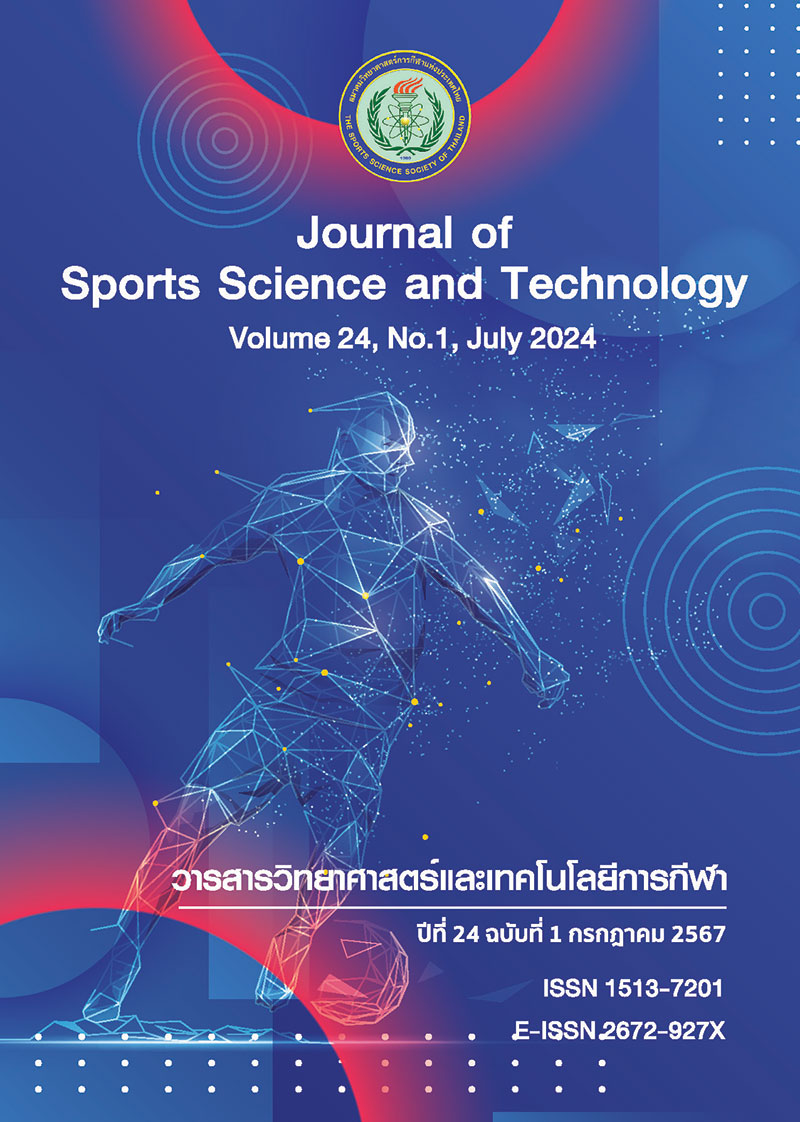ค่าการทรงตัวจากชุดทดสอบ KR balance kit ในการระบุความเสี่ยงต่อภาวะข้อเท้าไม่มั่นคงเรื้อรัง
คำสำคัญ:
ภาวะข้อเท้าไม่มั่นคงเรื้อรัง, การทรงตัว, ชุดทดสอบ KR balance kit, แบบประเมินภาวะข้อเท้าไม่มั่นคงบทคัดย่อ
ภาวะข้อเท้าไม่มั่นคงเรื้อรัง (Chronic Ankle Instability; CAI) พบได้บ่อยในนักกีฬาตลอดจนบุคคลทั่วไป ซึ่งอาจเป็นสาเหตุของความบกพร่องในการทรงตัวและความเสี่ยงในการเกิดการล้ม ชุดทดสอบ KR balance kit จึงถูกพัฒนาขึ้นเพื่อประเมินการทรงตัวและประเมินความเสี่ยงต่อภาวะ CAI ดังนั้น งานวิจัยนี้มีวัตถุประสงค์เพื่อ (1) หาเกณฑ์การทรงตัว (KR balance cut-off score) จากชุดทดสอบ KR balance kit ในการระบุความเสี่ยงต่อภาวะ CAI (2) เปรียบเทียบ KR balance score ระหว่างกลุ่มที่มีและไม่มีภาวะ CAI ภาวะข้อเท้าไม่มั่นคง (Non-Chronic Ankle Instability; NCAI) ผู้เข้าร่วมวิจัยจำนวน 114 คนถูกแบ่งออกเป็น 2 กลุ่ม ได้แก่ กลุ่ม CAI (57 คน) และกลุ่มที่ไม่มีภาวะ CAI (Non-Chronic Ankle Instability; NCAI) (57 คน) โดยใช้แบบประเมินภาวะข้อเท้าไม่มั่นคง (Cumberland Ankle Instability Tool; CAIT) เพื่อระบุภาวะ CAI หลังจากนั้น ผู้เข้าร่วมวิจัยแต่ละคนจะถูกทดสอบบนชุดทดสอบ KR balance kit เป็นเวลา 10 วินาที จำนวน 3 ครั้ง แล้วนำค่าเฉลี่ย KR balance score เปรียบเทียบระหว่างกลุ่ม และหาค่า KR balance cut-off score โดยใช้ ROC curve และคำนวณพื้นที่ใต้กราฟ (area under the curve - AUC) ผลการวิจัยในครั้งนี้พบว่า KR balance cut-off score ที่ > 2.96 แสดงถึงการมีความเสี่ยงต่อภาวะ CAI โดยมีค่าความไวในการทดสอบที่ 0.70 ค่าความจำเพาะในการทำสอบที่ 0.81 และมีความแม่นยำในการทดสอบเมื่อเทียบกับคะแนน CAIT อยู่ที่ร้อยละ 81 นอกจากนั้น ผู้เข้าร่วมวิจัยในกลุ่ม CAI มีค่า KR balance score มากกว่ากลุ่ม NCAI อย่างมีนัยสำคัญทางสถิติ (p < 0.01) ดังนั้นชุดทดสอบ KR balance kit สามารถใช้ระบุความเสี่ยงต่อภาวะ CAI ได้สอดคล้องกับแบบทดสอบ CAIT ชุดทดสอบใช้งานง่ายต่อการทำงานในภาคสนาม จึงน่าจะเป็นเครื่องมือที่เป็นทางเลือกให้กับบุคลากรทางการกีฬาตลอดจนบุคคลทั่วไปในการประเมินความเสี่ยงต่อภาวะ CAI ได้
เอกสารอ้างอิง
Attenborough AS, Hiller CE, Smith RM, Stuelcken M, Greene A, Sinclair PJ. Chronic ankle instability in
sporting populations. Sport Med. 2014;44(11):1545–56.
Tanen L, Docherty CL, Van Der Pol B, Simon J, Schrader J. Prevalence of chronic ankle instability in
high school and division I athletes. Foot Ankle Spec. 2014;7(1):37–44.
Gribble PA, Hertel J, Denegar CR, Buckley WE. The effects of fatigue and chronic ankle instability on
dynamic postural control. J Athl Train. 2004;39(4):321–9.
Pourkazemi F, Hiller CE, Raymond J, Nightingale EJ, Refshauge KM. Predictors of chronic ankle
instability after an index lateral ankle sprain: A systematic review. J Sci Med Sport. 2014;17(6):568–73.
Roos KG, Kerr ZY, Mauntel TC, Djoko A, Dompier TP, Wikstrom EA. The epidemiology of lateral
ligament complex ankle sprains in national collegiate athletic association sports. Am J Sports Med.
;45(1):201–9.
Martin RL, Davenport TE, Paulseth S, Wukich DK, Godges JJ. Ankle stability and movement
coordination impairments: Ankle ligament sprains. J Orthop Sports Phys Ther. 2013;43(9):A1–40.
Martin RRL, Davenport TE, Fraser JJ, Sawdon-Bea J, Carcia CR, Carroll LA, et al. Ankle stability and
movement coordination impairments: Lateral ankle ligament sprains revision 2021. J Orthop Sports Phys Ther.
;51(4):1–80.
McKeon JMM, McKeon PO. Evaluation of joint position recognition measurement variables associated
with chronic ankle instability: A meta-analysis. J Athl Train. 2012;47(4):444–56.
Munn J, Sullivan SJ, Schneiders AG. Evidence of sensorimotor deficits in functional ankle instability:
A systematic review with meta-analysis. J Sci Med Sport. 2010;13(1):2–12.
Hertel J. Sensorimotor deficits with ankle sprains and chronic ankle instability. Clin Sports Med.
;27(3):353–70.
Mckeon PO, Hertel J. Systematic review of postural control and lateral ankle instabilit, part I: Can
deficits be detected with instrumented testing? J Athl Train. 2008;43(3):293–304.
Thompson C, Schabrun S, Romero R, Bialocerkowski A, van Dieen J, Marshall P. Factors contributing
to chronic ankle instability: a systematic review and meta-analysis of systematic reviews. Sport Med.
;48(1):189–205.
Song K, Burcal CJ, Hertel J, Wikstrom EA. Increased visual sse in chronic ankle instability: a metaanalysis.
Med Sci Sports Exerc. 2016;48(10):2046–56.
Hiller CE, Nightingale EJ, Lin CWC, Coughlan GF, Caulfield B, Delahunt E. Characteristics of people
with recurrent ankle sprains: A systematic review with meta-analysis. Br J Sports Med. 2011;45(8):660–72.
Hertel J, Corbett RO. An updated model of chronic ankle instability. J Athl Train. 2019;54(6):572–88.
Richie J. Functional instability of the ankle and the role of neuromuscular control: A comprehensive
review. J Foot Ankle Surg. 2001;40(4):240–51.
Wenning M, Gehring D, Mauch M, Schmal H, Ritzmann R, Paul J. Functional deficits in chronic
mechanical ankle instability. J Orthop Surg Res. 2020;15(1):1–8.
Lin JZ, Lin YA, Lee HJ. Are landing biomechanics altered in elite athletes with chronic ankle instability.
J Sport Sci Med. 2019;18(4):653–62.
Gribble PA, Bleakley CM, Caulfield BM, Docherty CL, Fourchet F, Fong DTP, et al. Evidence review
for the 2016 International Ankle Consortium consensus statement on the prevalence, impact and long-term
consequences of lateral ankle sprains. Br J Sports Med. 2016;50(24):1496–505.
Herzog MM, Kerr ZY, Marshall SW, Wikstrom EA. Epidemiology of ankle sprains and chronic ankle
instability. J Athl Train. 2019;54(6):603–10.
Haas BM, Burden AM. Validity of weight distribution and sway measurements of the Balance
Performance Monitor. Physiother Res Int. 2000;5(1):19–32.
Uehlbauer T, Roth R, Mueller S, Granacher U. Intra and intersession reliability of balance measures
during one-leg standing in young adults. J strength Cond Res. 2011;25(8):2228–34.
Shaffer SW, Teyhen DS, Lorenson CL, Warren RL, Koreerat CM, Straseske CA, et al. Y-balance test:
A reliability study involving multiple raters. Mil Med. 2013;178(11):1264–70.
Fusco A, Giancotti GF, Fuchs PX, Wagner H, Varalda C, Cortis C. Wobble board balance assessment
in subjects with chronic ankle instability. Gait Posture. 2019;68:352–6.
Silva P de B, Oliveira AS, Mrachacz-Kersting N, Laessoe U, Kersting UG. Strategies for equilibrium
maintenance during single leg standing on a wobble board. Gait Posture. 2016;44:149–54.
Yingyongsaksri S, Hiller CE, Tharawadeepimuk K, Nanbancha A. Reliability and validation of the Thai
version of the Cumberland Ankle Instability Tool (CAIT-THA). Disabil Rehabil. 2022;0(0):1–6.
Mehta J, Sinha AGK. Prevalence of functional ankle instability and its association with risk factors in
basketball players of punjab. Int J Phys Educ Sports Health 2015;1(6):3–7.
Wright CJ, Arnold BL, Ross SE, Linens SW. Recalibration and validation of the Cumberland ankle
instability tool cutoff score for individuals with chronic ankle instability. Arch Phys Med Rehabil. 2014;95(10)
:1853–9.
Hiller CE, Refshauge KM, Bundy AC, Herbert RD, Kilbreath SL. The Cumberland ankle instability tool:
a report of validity and reliability testing. Arch Phys Med Rehabil. 2006;87(9):1235–41.
Bantis LE, Nakas CT, Reiser B. Construction of confidence regions in the ROC space after the
estimation of the optimal Youden index-based cut-off point. Biometrics. 2014;70(1):212–23.
Udompanich N, Thanasootr KO, Chanavirut R, Chatchawan U, Hunsawong T. The cut-off score of
four clinical tests to quantify balance impairment in individuals with chronic ankle instability. Malaysian J Med
Sci. 2021;28(4):87–96.
Hertel J, Olmsted-Kramer LC. Deficits in time-to-boundary measures of postural control with chronic
ankle instability. Gait Posture. 2007;25(1):33–9.






